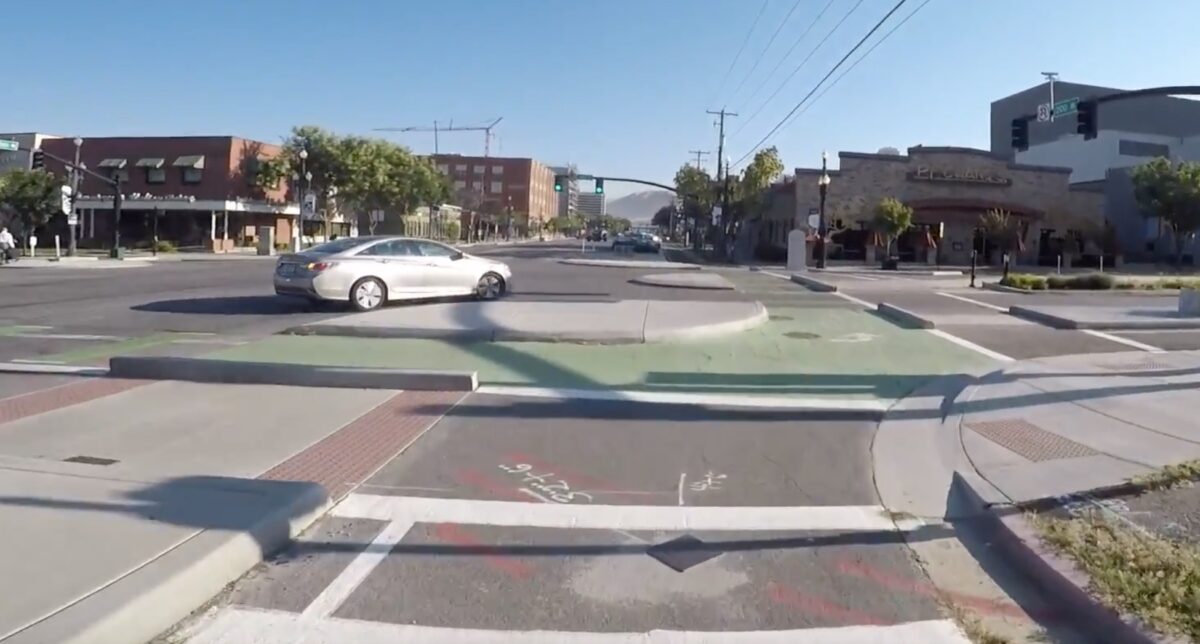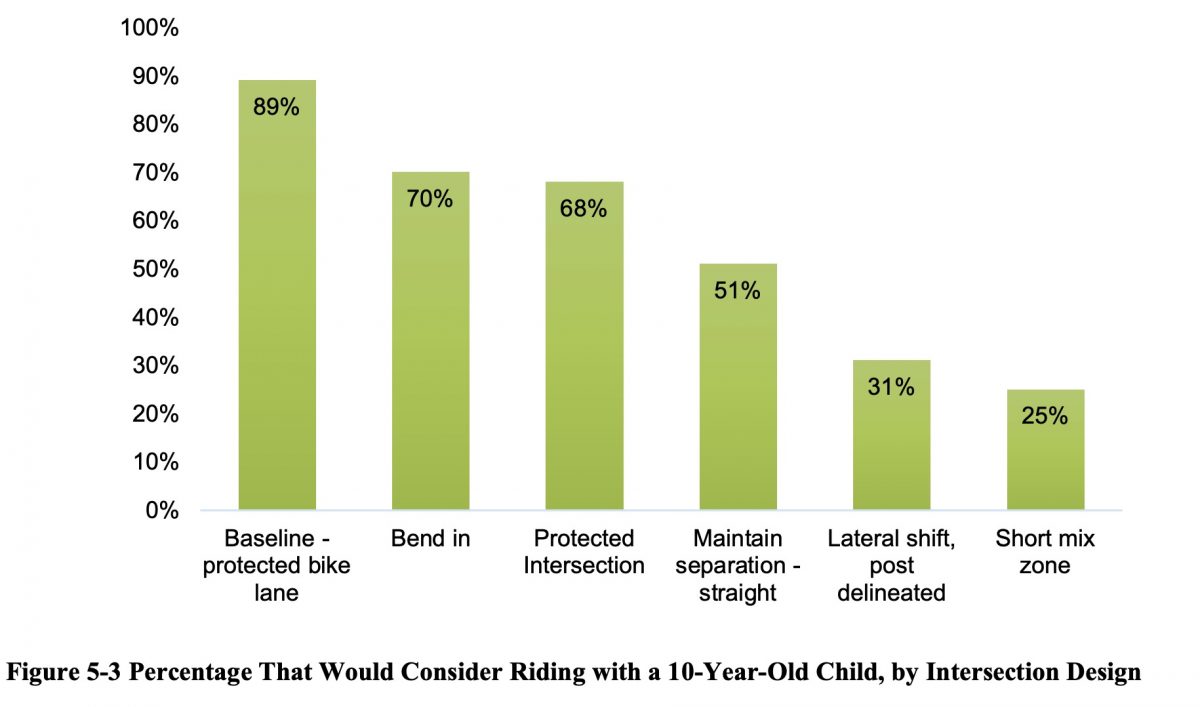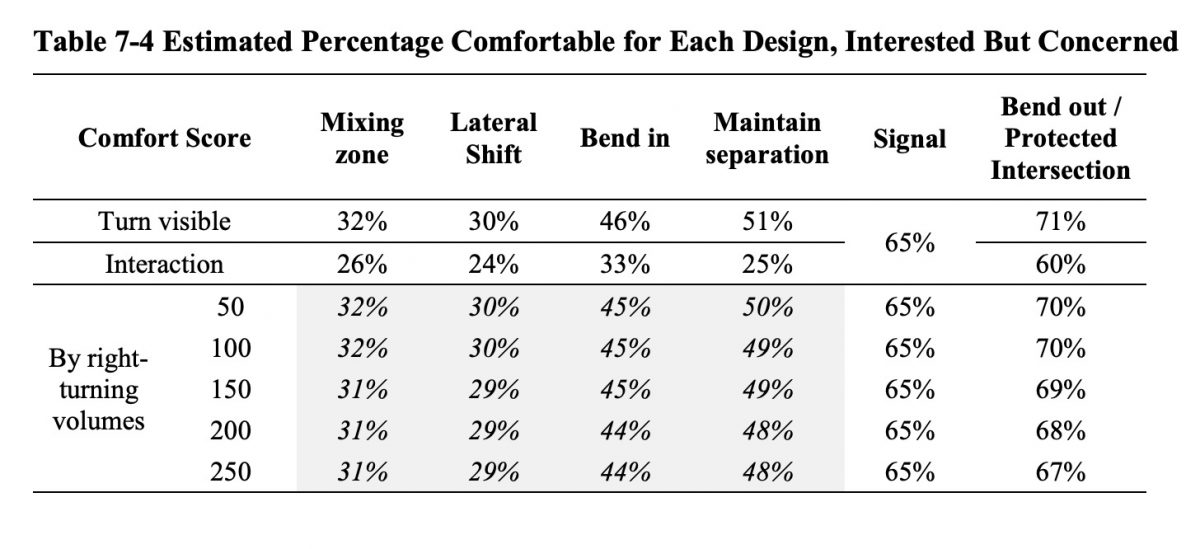
(Photo: TREC at PSU Researchers)
With protected bike lanes all the rage in Portland and throughout the U.S., a big question remains: What about intersections? After all, protection on the blockface doesn’t mean much when you come face-to-face with a drivers’ car at the intersection.

(Screen grab from TREC video)
New research released today from the Transportation Research and Education Center (TREC) at Portland State University set out to learn more about that question. What they found is that there are really only two types of bikeway designs that most people feel comfortable using, and they both include almost total separation from drivers.
The research team of Chris Monsere, Nathan McNeil and Yi Wang of Portland State University, along with Rebecca Sanders, Robert Burchfield (formerly PBOT’s head traffic engineer where he oversaw installation of Portland’s first-ever protected bike lane on SW Broadway) and William Schultheiss of Toole Design Group south to quantify the relative comfort level of a variety of bikeway design types among a variety of people.
Instead of crash data, they showed subjects helmet-mounted videos of bike lanes and asked, on a scale of 1 to 5, how comfortable they’d feel riding on it and whether or not they’d consider riding on it with a 10-year old child. A total of 277 people watched the clips during surveys taken in urban and suburban locations in Oregon, Minnesota, and Maryland. Researchers gleaned a total of 7,166 ratings from the surveys.
Advertisement



Five intersection types located in Seattle, Denver and Portland were studied: a separated bicycle traffic signal phase; a “bend-in” design that shifts the bike lane in toward other lanes; a “bend-out” design (a.k.a. protected intersection) that shifts the bike lane away from other traffic; a straight path that stays separated right up to the intersection; a “lateral shift” design that swaps the bike lane with other lanes and moves riders across the path of drivers; and a “mixing zone” design that terminates the bike lane and throws riders into the mix with turning drivers.

(Photo © J. Maus/BikePortland)
The findings show that comfort ratings plunge in places where bicycle riders are forced to mix with drivers prior to an intersection. If cities want to attract “interested but concerned” riders, researchers recommend only two of the designs: a separated bike signal phase or a protected intersection. “If you really want a bike network that’s comfortable for all ages and abilities,” said Chris Monsere from his office at PSU this morning, “It’s really just those two.”
Portland has a few bike signal intersections (NE Lloyd and Interstate at Peace Park, N Rosa Parks and I-5) and just one protected intersection (and it’s very new and in a relatively hidden location (NW 20th and Vaughn) without much traffic).
Unsurprisingly the intersections with the lowest comfort ratings were mixing zones and lateral shifts — where bicycle riders are forced to share space with other vehicle users. Mixing zones are a popular treatment at the Portland Bureau of Transportation. They just installed one on N Denver Avenue at Lombard (see photo at right).
Here’s the clip of a lateral shift design that got the lowest ratings:

Advertisement
And here’s the clip of the protected intersection (in Salt Lake City, Utah) that was rated most comfortable:

When asked the question about biking with a 10-year old, the straight protected bike lane (not at an intersection, used as a control) rated the highest with 89% of respondents saying they’d ride it with a child. Second place on the comfort rankings was a bend-in design from Denver, Colorado with 70% of respondents saying it would be comfortable. The later shift and mixing zone designs — both prevalent in Portland — were ranked as comfortable by only 31% and 25% of respondents, respectively.
There’s some data in the study that shows protected intersections result in more interactions between bicycle and car users — but is still considered comfortable because of the visibility and slow speeds the design encourages.
Another interesting aspect of this study is that researchers broke down results based on different rider typologies so you can see how “interested but concerned” riders’ views differ from “bike-inclined” (non-riders), or “strong and fearless”.
Learn more about the research and find all the downloads you need at trec.pdx.edu.
— Jonathan Maus: (503) 706-8804, @jonathan_maus on Twitter and jonathan@bikeportland.org
— Get our headlines delivered to your inbox.
— Support this independent community media outlet with a one-time contribution or monthly subscription.


